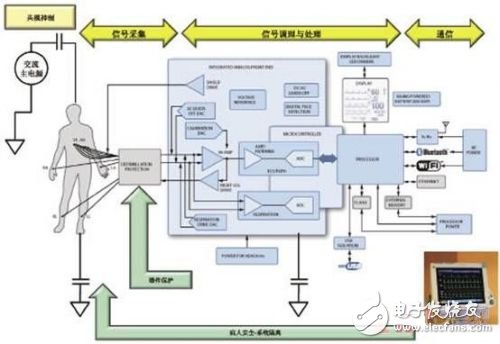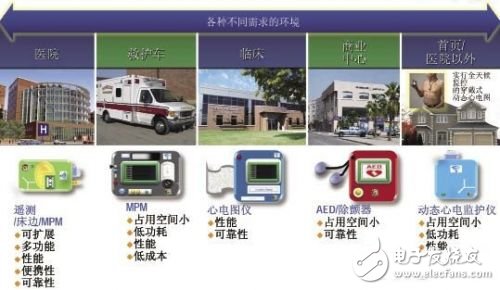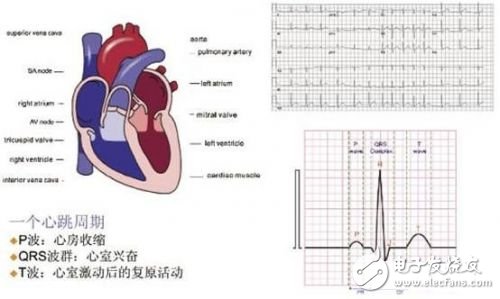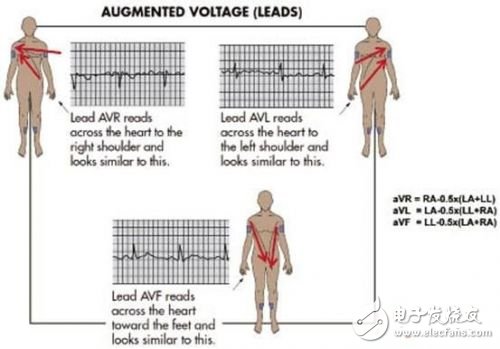It is not difficult to find in higher level systems and component systems of patient monitoring equipment that many data acquisition systems have typical signal chains, including signal acquisition, signal conditioning and processing, and work communication. If you delve deeper, you will find that there are many design issues that need to be understood, such as signal integrity and the impact of common mode rejection on the signal. It is also important to ensure the safety of patients using electrical connection equipment, but this adds to the complexity of the design. Patients may sometimes need to undergo defibrillation, and at this time we must prevent the system itself from being affected by such activities. Not only that, but many other industry norms and practical problems in practice can also affect the final design of the system.
Figure 1 shows the typical signal chain of a 12-lead ECG (electrocardiogram) monitoring device. The architecture is very complex and there are various nuances and complexities.

ECG monitoring
The measurement of ECG, the electrical activity of the heart. Devices that measure ECG signals include portable dynamic ECG monitors, clinical electrocardiographs, and high-channel cardiac mapping systems, which are constantly being developed. These measurement systems use a wide range of environments, and some of them are typical in Figure 2. For example, the hospital's use environment includes operating room, intensive care unit, electrophysiology laboratory, etc. Each environment has design problems that need to be solved. The complexity and measurement goals of the design challenges faced by these environments are extensive and the scope is still expanding. As the healthcare industry moves toward remote patient monitoring, developers face a host of new challenges that require new responses.
ECG signal
The ECG signal is a transthoracic reflection of the electrical activity of the heart over a period of time, collected by the skin electrode and recorded externally. It is a non-invasive record generated by an electrocardiograph device. The amplitude of the ECG signal is usually 0.25mV~5mV, which is composed of various waves, such as normal sinus rhythm map. Deviations from normal sinus rhythm indicate that there may be an abnormality that the doctor can use to assess the patient's health and respond accordingly.
The sampling map of the ECG signal consists of P wave, QRS complex and T wave, representing the electrical activity of the heart in a cardiac cycle. A heartbeat cycle P wave: atrial contraction; QRS complex: ventricular excitation; T wave: recovery activity after ventricular activation. Today, by studying the electrical properties of different levels of the heart, cardiologists can identify many anomalies associated with cardiac function. As shown in Figure 3.
ECG measurement
In ECG measurements, the electrodes are potential sensors placed in various parts of the chest and/or limbs. The leads come from various mathematical combinations of ECG electrodes. Although for historical reasons, some people think this is outdated, in the clinical environment, the 12-lead ECG is still the most common setting. The 12-lead ECG includes three standard limb leads, the right arm, the left arm, and the left leg, called the Einthoven lead. There are also three pressurized limb leads VR, VL and VF, also known as the Goldberg pressurization lead, and six pre-cardiac lead leads, V1~V6. The precordial lead is also called the V lead, and most cardiologists consider it to be an independent vector, which is the difference between the Wilson center and the target V electrode. The Wilson Center itself consists of a right arm, a left arm, and a left leg lead that can be divided by three. We can see that to form a 12-lead ECG, just connect 9 electrodes. The 10th electrode is also typically used to provide "right leg drive", and as the mapped heart level increases, measuring cardiac bioelectrical signals becomes more complex.
As shown in Figure 4, the Einthoven lead can be viewed as an independent vector as well as the V lead, with signals coming from leads 1, 2, and 3, measured from between the arms or between one arm and the left leg. The pressurization leads aVL, aVR and aVF are derived from the same three electrodes as the leads 1, 2, 3. Taking aVL as an example, the positive electrode is the left arm and the negative electrode is the combination of the right leg and the right arm. Therefore, the above leads do not belong to independent leads. In the chest lead connection V1 ~ V6, 6 positive electrodes placed in the chest, the Wilson center end of the aforementioned reference as a measurement reference is equivalent to the negative electrode.

Figure 2 Environment that requires ECG monitoring in the healthcare system

Figure 3 ECG signal

Figure 4 AVx lead measurement through the heart
Rubber cable is also rubber sheathed cable. As its name implies, it is a wire and cable with various rubbers or thermosetting elastomers with equivalent performance as the insulation and sheath foundation.
Because of its unique flexibility, rubber sheathed cables are very suitable for use in indoor and outdoor environments, including wet and even water conditions. They are usually used on mobile electrical equipment. They are suitable for electrical and pneumatic connection or wiring with AC rated voltage of 300V/500V and 450V/750V below.
Rubber sheathed cables are used by products in many fields due to their unique mechanical and physical properties, so they are classified into many categories, such as mobile universal rubber sheathed cables, electric welding machines, electric power, marine, mining, wind energy, nuclear energy, etc., among which mobile universal rubber sheathed cables and mining cables are widely used.
Advantages
1. Good water resistance, less air permeability.2. It can be mixed with other rubber or plastics to improve the performance of rubber.
3. Good heat resistance. The heat resistance of rubber is better than that of natural rubber and styrene butadiene rubber.
4. The physical and mechanical properties are average. The mechanical properties of rubber without reinforcing agent are poor.
5. It has excellent oil resistance and solvent resistance. The higher the content of acrylonitrile, the better the oil resistance.
Rubber Cable,Rubber Welding Cable,Outdoor Copper Wire Rubber Cable,Flexible Rubber Sheathed Cable
Ruitian Cable CO.,LTD. , https://www.hbruitiancable.com